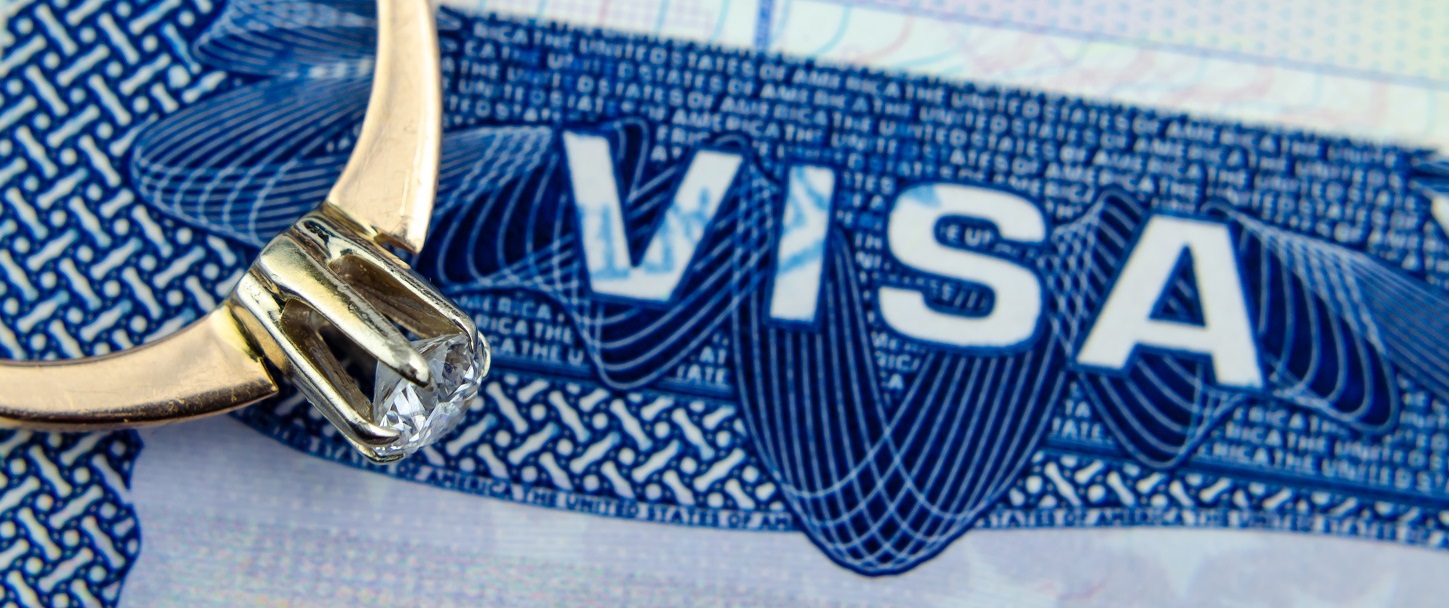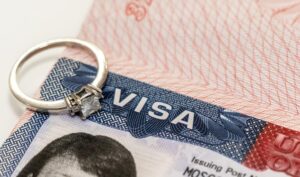
Immigration officials, from the U.S. Department of State and also U.S. Citizenship and Immigration Services (USCIS), scrutinize spouse relationships more than other types of immigrant visa applications. That’s because there has been a historically high rate of visa fraud for marriages as compared to other relationships. Therefore, immigration officials want reassurance that the marriage is legitimate and that the foreign spouse is obtaining a green card based on a genuine relationship. This article reviews the requirements for a spouse visa, steps to apply, and how to make sure you're doing it correctly.
Why are there different (IR1/CR1) spouse visas?
Who is eligible to sponsor a spouse?
What are the specific steps to get started on a spouse visa?
Is the process different if my spouse is in the U.S. or abroad?
How much does this cost?
What else should I know about?
How long will it take for my spouse to get a green card?
Is there an option if we're not married yet?
How can CitizenPath help me and my spouse?
Spouse Visa (IR1/CR1 Visa) Explained
A “spouse visa” in this article is a term to refer to an immigrant visa (green card) for spouses. The U.S. government may issue an immigrant visa to the foreign national spouse of a U.S. citizen or lawful permanent resident. You may hear terms like IR1, CR1 and F2A to describe the visa types. The fact is, you have no choice in the matter. These "classes of admission" are based on the type of qualifying relationship, the duration of the marriage, and sometimes the type of admission. Here are some common examples:
- IR1: Lawful permanent residence granted to the foreign national spouse of a U.S. citizen
- F2A: Lawful permanent residence granted to the foreign national spouse of a permanent resident
- CR1: Conditional permanent residence granted to the foreign national spouse of a U.S. citizen
Spouses admitted under the IR1 or F2A categories receive a permanent resident card, also known as a green card. Although permanent resident status is generally permanent, these cards are valid for a period of 10 years and must be renewed at that point. For couples who have been married less than two years at the time the immigrant visa is granted, the government will issue a “CR1” visa. CR1 spouses are issued a conditional green card that is valid for a period of two years. Within the 90-day period before the card expires, conditional residents must "remove the conditions on residence" in order to maintain status. Many spouse visa beneficiaries are approved as conditional residents.
Eligibility to File a Visa Petition for a Spouse
Before a foreign national may actually apply for a spouse visa, the U.S. citizen or permanent resident must file a petition to establish the existence of a qualifying relationship. Although there are additional requirements for a successful spouse petition, the eligibility is fairly straight forward. The petitioner must:
- Be a U.S. citizen or permanent resident (age 18 or over); and
- Be legally married to the foreign national spouse.
The visa petition starts the process. Initially, the U.S. citizen or permanent resident files Form I-130 (Petition for Alien Relative) and Form I-130A (Supplemental Information for a Spouse Beneficiary) with USCIS. The visa petition package establishes a qualifying relationship and requests the U.S. government to make a visa available to a foreign national spouse.
Same-sex marriages and marriages to transgender spouses are included in marriage-based green card petitions. In other words, they are treated the same as opposite-sex marriages.
Filing Your Spouse's Petition
Filing the petition package involves more than just the government forms. It’s extremely important to prepare a complete I-130 petition package with all of the necessary supporting documents when filing for a spouse visa. USCIS may send a Request for Evidence (RFE) if any information is missing. This additional step will delay the case and increase the time it takes to approve the petition. The typical I-130 petition package will include:
USCIS Filing Fee
Submit a payment for your USCIS fees. Make the check or money order payable to U.S. Department of Homeland Security. (The fee is $535 fee at the time of writing this article.)
Cover letter (optional)
A cover letter is not required, but it can help itemize the documents that you are submitting and highlight any extraordinary circumstances that you want to clarify. Review a sample I-130 cover letter.
Form I-130, Petition for Alien Relative
Submit an accurately prepared visa petition. A well-prepared petition is the best way to keep your case on schedule. Don’t forget to sign.
Form I-130A, Supplemental Information for Spouse Beneficiary
The Form I-130A is only required for the beneficiary spouse. If your spouse is outside the United States, he or she is not required to sign Form I-130A.
Proof of status
If you are a U.S. citizen, submit a photocopy of a birth certificate (if U.S. born), passport, naturalization certificate, certificate of citizenship, or consular report of birth abroad. If you are a lawful permanent resident, submit a photocopy of both sides of your green card or other proof of permanent residence.
Marriage certificate
Include a copy of your marriage certificate to prove that there is a family relationship between you and your spouse.
Proof of previous marriages terminated
If either you or your spouse were previously married, submit copies of documents showing that all prior marriages were legally terminated such as a divorce decree or death certificate (if the marriage was terminated due to the death of a spouse).
Passport photos
Submit two passport-style color photos of yourself and two passport-style color photos of your spouse taken within 30 days of filing the petition. (Exception: The foreign national spouse does not need to submit photos if currently residing outside the U.S.)
Evidence of a bona fide marriage
Include evidence that you have a bona fide marriage. It’s important to demonstrate you married for genuine reasons, not to evade U.S. immigration laws for the sole purpose of obtaining a green card. You’ll need to submit copies of documents that show evidence of shared financials liabilities, assets, insurance, tax filings, birth certificates of child born in to the marriage, or other documents that you feel shows your bona fide relationship. Read Evidence of Bona Fide Marriage to Support a Spousal I-130 Petition for more extensive information and example evidence.
The example I-130 package described above is for a typical spouse visa case. Depending on your specific case and how you answer questions on the petition, additional documents and evidence may be required at the time of filing.
CitizenPath's Immigrant Visa Petition Package can help you prepare the petition. Our affordable software was designed by immigration attorneys to make the process easier and help eliminate common errors that create delays and rejections. Upon completion, you’ll receive the Form I-130, Form I-130A (ready to sign) and filing instructions with a checklist of supporting documents for your specific situation.
Your Spouse's Path to a Green Card
The information above assumes that your spouse is outside of the United States. Upon approval of the I-130 petition package, USCIS forwards the case to U.S. embassy or consulate where your spouse will ultimately apply for the visa and interview. This is called consular processing. However, in certain cases when a spouse is inside the United States, your spouse may be eligible for adjustment of status.
Consular Processing
Most family-based green card applications go through consular processing. The applicant is located abroad and interviews at a U.S. embassy or consulate.
The basic steps through the spouse visa process are as follows:
- File I-130 Petition Package with USCIS
- Obtain USCIS approval (or denial) on petition
- Submit Affidavit of Support (I-864) and other documentation to National Visa Center
- Pay and apply for immigrant visa (DS-260)
- Complete required medical exam
- Attend visa interview at the U.S. embassy or consulate
- Receive immigrant visa in passport
- Pay immigrant fee online
- Travel to United States
- Receive physical green card in the mail (typically about four weeks of entry)
Adjustment of Status
Certain spouses who are already inside the United States may be able to adjust status to permanent resident. This means that they would apply for the green card inside the United States without the need to travel abroad for an interview. This option is not available to everyone. Eligibility requires that the foreign national spouse:
- Be physically present in the U.S. through a lawful entry; and
- Have an immigrant visa immediately available to them.
Typically, physical presence should be through an entry with nonimmigrant intent. For example, your spouse shouldn't enter on a B-2 visitor visa with the preconceived intent of adjusting status.
There is no annual limit on the number of immigrant visas issued to spouses of U.S. citizens. Therefore, a visa is always immediately available. However, there may be a wait period for spouses of permanent residents. They need to make sure the category is "current" in the visa bulletin. Currently, the F2A category is current and visas are available.
When adjusting status, generally there is no need to file Form I-130 and wait. Instead, the foreign national spouse may file an adjustment of status package that includes Forms I-130, I-130A and I-485 (Application to Adjust Status).
Forms & Expenses for Spousal Immigration
The cost considerations below are for a spouse visa through consular processing. The adjustment of status path (for applicants physically present in the U.S.) come with additional costs.
| Fees for USCIS, NVC or U.S. Consulate | Fee (USD) |
|---|---|
| Form I-130, Petition for Alien Relative | $535 |
| Form I-130A, Supplemental Information for Spouse Beneficiary | $0 |
| DS-260, Immigrant Visa Application | $325 |
| Form I-864, Affidavit of Support | $120 |
| Form I-693, Report of Medical Examination and Vaccination Record | $0 |
| USCIS Immigrant Fee | $220 |
| Total Cost for Typical Spouse Visa | $1,200 |
There are other costs associated with an application for a spouse visa. For example, every applicant must attend a medical exam completed by an embassy-approved physician. There is no fee for the form. However, the doctor will charge a fee for the exam. The cost of the required medical exam will vary by country, doctor, and any additional vaccinations that may be required. Other costs may include photos to submit with the application, postage, and any transportation fees associated with travel to a consular interview.
The forms and fees above are specific to consular processing. For adjustment of status, we have a tool to help you determine the typical forms and forms. There are tradeoffs between consular processing and adjustment of status. Couples who have a choice between the options may gain insight on all aspects of consular processing versus adjustment of status.
Inadmissibility
After USCIS approves the immigrant visa petition and a visa is available, the foreign national applies for the actual spouse visa. Immigration officials will review the intending immigrant’s background for grounds of inadmissibility. In fact, everyone who applies to enter the United States is checked for inadmissibility. In general, immigration officials will not allow intending immigrants with histories of criminal or terrorist activities, drug abuse, infectious medical problems, or certain other characteristics to enter the U.S.
The following list summarizes some of the major classes of inadmissibility. In some cases, a waiver can be obtained.
| Classes of Inadmissibility | Waiver Available? |
| People with communicable diseases like tuberculosis | |
| People with physical or mental disorders that may cause harm to themselves or others | |
| Drug abusers or addicts | |
| Drug traffickers | |
| People without proper vaccinations | |
| People with convictions for crimes involving moral turpitude | |
| Prostitutes | |
| People with multiple criminal convictions | |
| People who have violated immigration laws | |
| Spies | |
| Terrorists | |
| Nazis | |
| People likely to become dependent on need-based government assistance |
If your situation may include any of the above conditions, please consult with an immigration attorney before attempting to file any USCIS form.
If these issues do not apply to your situation, you can likely and save hundreds of dollars compared to an immigration attorney.
Processing Times to Get a Spouse a Visa
As mentioned in a previous section, the I-130 petition is a request by the U.S. citizen or permanent resident to make a visa available to a foreign spouse. For spouses of U.S. citizens, a visa is always available. Spouses of U.S. citizens are considered immediate relatives. On the other hand, spouses of permanent residents are considered family preference immigrants and may experience a bit more of a wait for a visa to become available. However, once USCIS approves the petition, the process is essentially the same for both.
For many spouse visa cases, the process takes less than a year. The entire spouse visa time line can vary for your case. As mentioned, I-130 processing times vary by type of relationship (immediate relative or family preference). Other factors that affect processing time include the workload where your paperwork is processed and how well you prepare the petition.
Getting a Visa Before Marriage
There is alternative path for couples not yet married. The fiancé of U.S. citizens may generally obtain a K-1 visa to enter the United States for the purposes of marriage. The foreign national must marry the U.S. citizen within 90 days of entry to the U.S. If not married at this point, he or she must depart the country. Once married to the U.S. citizen, the K-1 visa holder may adjust status to permanent resident.
Removing Conditions from a Spouse's Conditional Green Card
As mentioned, immigration officials issue a conditional green card (CR1 visa) to immigrants who have been married less than two years. In the 90-day period before the two-year green card expires, the immigrant must "remove the conditions on residence." It's an extra step, but it's manageable for most couples. Understanding the purpose of the conditional period and which supporting documents are necessary to remove the conditions can streamline the process.
About CitizenPath
CitizenPath provides simple, affordable, step-by-step guidance through USCIS immigration applications. Individuals, attorneys and non-profits use the service on desktop or mobile device to prepare immigration forms accurately, avoiding costly delays. CitizenPath allows users to try the service for free and provides a 100% money-back guarantee that USCIS will approve the application or petition. We provide support for the Immigrant Visa Petition Package (Form I-130), Adjustment of Status Package (Forms I-485 and I-130), and several other immigration services.
Want more immigration tips and how-to information for your family?
Sign up for CitizenPath’s FREE immigration newsletter and
SAVE 10%
on our immigration services









